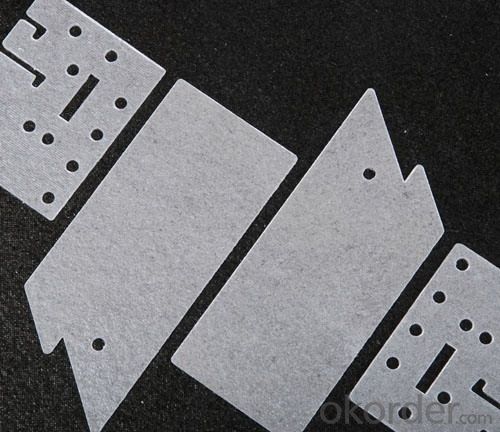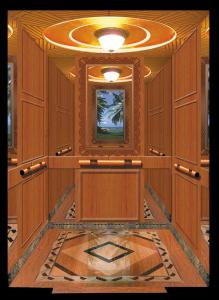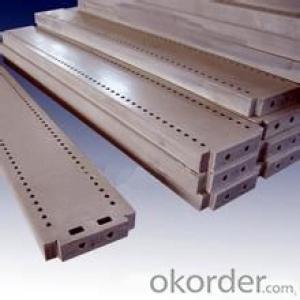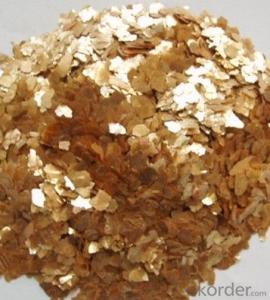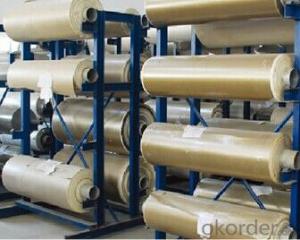Mica Parts Used in Refractory Industry Field
- Loading Port:
- Shanghai
- Payment Terms:
- TT OR LC
- Min Order Qty:
- 100 pc
- Supply Capability:
- 10000 pc/month
OKorder Service Pledge
OKorder Financial Service
You Might Also Like
1. Introduction:
Typical applications of mica heating elements are air heaters, enclosure systems, food service equipment, process and packaging equipment.
2. Main features of Mica Parts:
Mica is a rigid substrate able to withstand very high temperatures and are suited for applications up to 500°F (260°C).
Mica heating elements offer several distinct advantages over other flexible heater technologies, including extremely low leakage, lower material costs, and higher operating temperatures.
Our mica heating element is made by detail order requirments.
3. Technical Parameters:
MICA SHEET -----Technical data | ||||||||
ITEM | UNIT | RM | RP | RM-T | RP-T | FM | FP | |
Hardness |
| Rigid | Rigid | Rigid | Rigid | Flexible | Flexible | |
Mica paper |
| Muscovite | Phlogopite | Muscovite | Phlogopite | Muscovite | Phlogopite | |
Thickness | mm | 0.1-2.0 | 0.1-2.0 | 3.0-50 | 3.0-50 | 0.1-2.0 | 0.1-2.0 | |
Mica content | % | ≥90 | ≥90 | >88 | >88 | ≥90 | ≥90 | |
Bond Content | % | <10< span=""> | <10< span=""> | <12< span=""> | <12< span=""> | <10< span=""> | <10< span=""> | |
Density | g/m 3 | 1.6~2.45 | 1.6~2.45 | 2.1~2.4 | 2.1~2.4 | 1.6~2.45 | 1.6~2.45 | |
Heat | Continuous | ℃ | 500 | 700 | 500 | 700 | 500 | 700 |
Peak | ℃ | 700 | 900 | 700 | 900 | 700 | 900 | |
Heat loss at 500℃ | % | <1< span=""> | <1< span=""> | <1< span=""> | <2< span=""> | <1< span=""> | <1< span=""> | |
Heat loss at 700℃ | % | <2< span=""> | <2< span=""> | <1< span=""> | <2< span=""> | <2< span=""> | <2< span=""> | |
Flexural strength | Mpa | >160 | >140 | — | — | <1< span=""> | <1< span=""> | |
Water absorption 24h/23°C | % | <1< span=""> | <1< span=""> | <1< span=""> | <2< span=""> | — | — | |
Dielectric strength | KV/mm | >20 | >20 | >15 | >15 | >15 | >15 | |
Volume | 23℃ | ΩNaN | >1017 | >1017 | >1017 | >1017 | — | — |
500℃ | ΩNaN | >1012 | >1012 | >1012 | >1012 | — | — | |
Smoking Test | s | <4< span=""> | <4< span=""> | — | — | — | — | |
FAQ
We have organized several common questions for our clients,may help you sincerely:
--------What is the use of mica parts?
Mica laminate and washers made of our own high quality mica plates are used for home appliances, electro-magnets, micro-sensitive control gear etc
---------Which type of mica parts we can produce?
1. Rigid mica parts or Flexible mica parts
2. Muscovite mica parts or phlogopite mica parts
3. Thin mica parts or thick mica parts
4. All the special sized mica parts need drawing.
----------what advantages of mica parts?
1. Good high voltage insulation materials
2. Do not easily break up
3. Easily produce special size
- Q: What is the electrical performance of insulating materials
- Such as the rated voltage, current, active power, reactive power, resistance, capacitance, inductance, conductance; semiconductor is famous, DC magnification, AC magnification, rectified current, reverse breakdown voltage, forward voltage , The junction voltage, the noise figure, the characteristic frequency, the cut-off frequency, the dissipation power ... the IC is also very large, the maximum working voltage, the op amp's pendulum speed, the bandwidth, the distortion coefficient, the ADC conversion rate, , The resolution of plastic in the field of electrical applications is extremely extensive, its role is mainly two aspects, one as electrical insulation materials, two for the mechanical structure of materials. These materials are used in the field of electrical engineering, mainly in the electrical, electrical and electrical industries.
- Q: What is the 8 ° C rule for insulating materials?
- The service life will be greatly shortened, such as ATR insulation material limit working temperature of 105 ℃, when the ultimate working temperature of 8, the life will be reduced by about half, which is the so-called 8 ℃ thermal deterioration rules
- Q: What type of enameled wire and insulation material is used for the compressor
- Enclosed wire and insulation materials for fully enclosed compressors: 1) Refrigerant R12, enameled wire with high strength polyester QZ, insulated with 6400 epoxy resin Insulation H34-4, Polyurethane film for insulating material Green paper (DMD ) Insulation paper; 2) refrigerant R22 and R502, with QF, QXY polyamide imide enameled wire, insulation treatment with EIU epoxy modified impregnated varnish, insulating material with polyimide film and poly Fiber composite foil, F-class insulation DMD insulation paper.
- Q: What insulating material is used for high voltage cables
- YJLV23 Aluminum core XLPE insulated steel tape armored PVC sheathed power cable YJV32 copper core XLPE insulated fine steel wire armored PVC sheathed power cable indoor, tunnel, cable trench, shaft or buried
- Q: Who knows what are the ability of 1300 degrees above the high temperature, insulation materials?
- Such as tungsten, molybdenum, tantalum, niobium, vanadium, chromium, titanium, zirconium and other refractory metals and rare earth metal borides, carbides, nitrides, silicides, phosphides and sulfides; the latter such as boron carbide, Silicon carbide, boron nitride, silicon nitride, boron phosphide, silicon phosphide and the like. The latter has a very important use, can be used as high temperature refractory materials (such as abrasive, mold, nozzle, high temperature thermocouple casing), heat-resistant materials (such as rocket structure components, nuclear engineering materials, electric components), electrical materials Such as high temperature thermocouple, ignition electrode), in addition to chemical resistance materials and hard materials.
- Q: What is the insulating material in the middle of the connecting wire?
- Looked for a long time to understand your problem, I can see with a relatively thin tube into the insulation, the insulation tube into a plug in the insulation of the skin. Or for the wire, without the foreskin of the wire is not safe
- Q: What are the gas insulation materials?
- The relative breakdown strength of air (at air 1) at the standard pressure (101335Pa) is as follows: nitrogen, 1; hydrogen, 0.5; carbon dioxide, 0.9; sulfur hexafluoride, 2.5; freon-12,2.7 The
- Q: What is the main purpose of insulating materials?
- Tensile strength: The cross-sectional area of the insulating material can withstand tensile forces, such as glass per square centimeter cross-sectional area can withstand the resistance of 1400 Newton.
- Q: What is the DMD insulation material?
- DMD (Dacron / Mylar / Dacron) full name polyester film polyester fiber non-woven soft composite foil, is a two-layer polyester non-woven fabric in the middle of a layer of insulated polyester film composite made of three insulation materials.
- Q: What insulating material is best `?
- Insulation materials, also known as insulation materials. Insulation material refers to the electrical insulation material, the conductivity of about 10-10 West / m below. According to the needs of different electrical products, but also from the storage Can, heat, cooling, arc, moisture, mildew, anti-corrosion, anti-radiation, mechanical support and fixed, protective conductor and so on.
Send your message to us
Mica Parts Used in Refractory Industry Field
- Loading Port:
- Shanghai
- Payment Terms:
- TT OR LC
- Min Order Qty:
- 100 pc
- Supply Capability:
- 10000 pc/month
OKorder Service Pledge
OKorder Financial Service
Similar products
Hot products
Hot Searches



